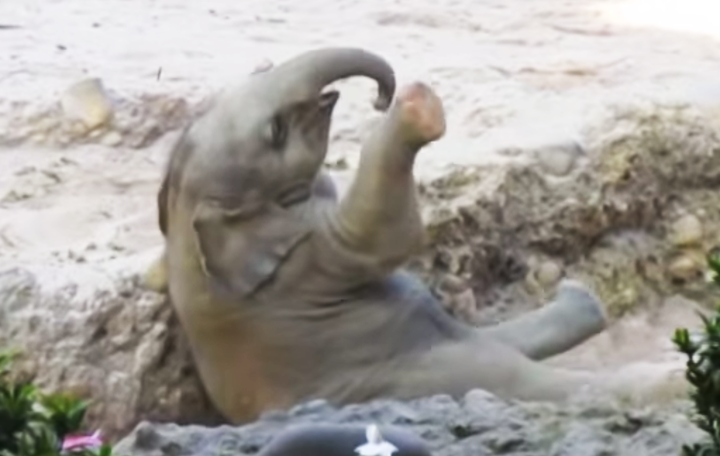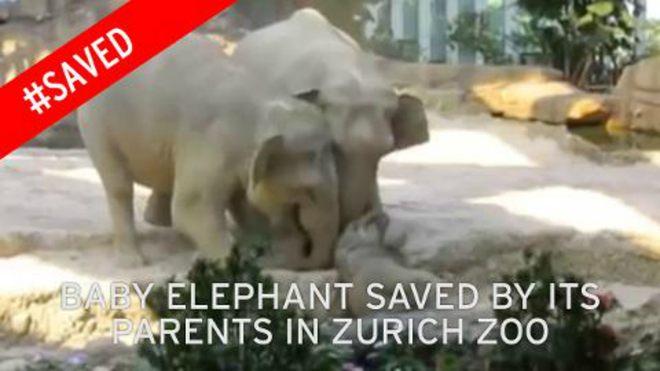When This Baby Elephant Cried, Mom And Super-Auntie Rescued
An amazing video of zoo elephants racing to save a baby elephant beautifully illustrates that aunties not daddies help raise the young.
By Vicki Croke
A breathtaking scene captured earlier this summer on a mobile phone, became a sensation a few days ago.
Omysha tumbles onto her back and cries out.

The video shows a 6-week-old baby Asian elephant named Omysha at the Zurich Zoo: The little calf tumbles onto her back while attempting to climb a small ridge, and the moment she cries out in panic, a pair of adult elephants races to her rescue—cooperatively righting her with their trunks, protectively herding her, and vocalizing.
It is a beautiful moment showing the intelligence, compassion, and even courage of elephants (after all, those adult elephants didn’t know what kind of threat they’d be facing when they heard the baby cry, they simply flew in to the rescue.)
[youtube=http://www.youtube.com/watch?v=ReNavhcXUYk]
Several media outlets quickly reported that Omysha’s “parents” had saved her. My mother (a super-tuned-in trend spotter) was the first to alert me.
Knowing what I do about elephant families, I said, “I’d be very shocked if the father was involved.”
“That’s what they said on TV!” Mom replied defensively.
I wasn’t doubting the accuracy of my mother’s reporting, I was questioning the broadcast. And with good reason. It turns out that Omysha’s father Maxi, as I suspected, was not involved in the incident. It was the baby’s 28-year-old mother Indi and another female elephant who were the video sensations. In the absence of that information, some TV and print reporters announced that the two adult elephants caring for Omysha were Mommy and Daddy.
One version of the video circulating online that claimed the rescuing elephants were Omysha’s mother and father.

Err. Elephant society is not set up like an American nuclear family (in fact, many American nuclear families are not set up like American nuclear families, but that’s another story).
So was this misguided assumption of how elephant parenthood works unusual? I contacted Nigel Rothfels from the University of Wisconsin-Milwaukee.
He’s a historian and author who has focused on how our ideas about elephants have changed over the last centuries.
“It is surprising how often people expect elephants to live in what used to be called ‘nuclear families,’” he emailed. “This idea pops up in all kinds of surprising places, despite the fact that elephants do not normally live like this in the wild and have essentially never been shown this way in zoological gardens. It is true that anyone who has ever played the video game Zoo Tycoon ‘knows’ that elephants are only happy when they are living in heterosexual pairs; apparently, neither elephants nor zookeepers are aware of this.”
So, how do elephants live then? Elephant family groups tend to consist of a matriarch (an experienced female) and some combination of her sisters, daughters, and their male and female offspring. The males leave the group as they mature, and they live alone or in loose bachelor groups from then on.
In the wild and in captivity (when allowed), females in the group look out for the young ones together. Babies often have not just their mother but also an auntie or several aunties caring for them.
My new book “Elephant Company,” about J.H. Williams, an Englishman who fell in love with the working elephants of Burma (now Myanmar) in the 1920s through the 1940s, contains several stories of the adventures of auntie elephants. Williams learned about them early in his jungle life:
Captive elephants did not form the mother-daughter-sister dynasties that wild ones built over generations. Circumstances didn’t allow it. But they did cleave to one another just the same. Among the logging elephants, blood kinship wasn’t necessary—they had figured out how to sustain ties just as enduring among themselves. Often the [elephant handlers] would witness a kind of shared parenting, in which females bonded with one another so closely that they reared their calves together. The men used the term twai sin in reference to these inseparable female elephants: aunties. When a calf bellowed in distress, not only his mother, but his auntie would come running. Separating such bonded elephants was wrong, “indeed cruel,” Williams thought as soon as he saw the consequences.
Just how strong are these bonds? In her remarkable book “Silent Thunder,” biologist Katy Payne tells the story of an elderly elephant, Tuy Hoa, a resident of what is now the Oregon Zoo, who had an extreme reaction when her daughter Hanako gave birth.
Within two weeks an extraordinary thing happened. Milk formed in the old grandmother’s breasts, although she had not had a calf of her own for several years. Along with Hanako, Tuy Hoa nursed the last of her descendants to be born in her lifetime.
There are many stories in the literature about mothers and those aunties protecting, pampering, and disciplining the babies of the group. The most basic and abiding elephant family unit is run and maintained by the females.
But that’s not to say that male elephants are slouches when it comes to what I would label compassion.
And I was reminded of that yesterday when I phoned one of my most gifted elephant gurus—Dr. William Langbauer.
In a photo from Dr. Bill Langbauer taken in South Africa, we see elephants forming a protective circle around a newborn baby (who is hidden). Dr. Bill points out that when the big female on the right called out in alarm, the juvenile bull (seen facing us in the middle) quickly took his place in the “defensive star” guarding
the baby.

Dr. Bill teaches at Bridgewater State and studies wild elephants in Africa. He was Katy Payne’s colleague and collaborator in the early days, in the 1980s, of discovering that elephants use infrasound, sound which is too low-frequency for human hearing. He said that though it’s true that fatherhood in elephants isn’t a very hands-on (trunks-on?) role, we shouldn’t forget that male elephants are more than capable of helping others and exhibiting “care-giving behavior.” (This, I think, is Dr. Bill’s term for what I call compassion.)
Katy Payne’s book also contains stories of male elephants looking out for each other. One very dear illustration took place on a horribly hot day in Etosha National Park. Payne witnessed an older elephant bull standing in the open sun, about a kilometer from a watering hole, shading a younger, smaller one with his own ear.
Payne and Langbauer worked together in Etosha, and Dr. Bill recalled an extraordinary scene he witnessed there decades ago. He was on a supply run with a colleague. They saw three adult elephants swaying close together in the distance, two of the elephants trying to help the third who was obviously ill. “We assumed it was three females,” Dr. Bill said. But as he got closer, he realized it was three males. Each time the sick elephant would collapse, the other two would use their tusks to lift him up. And once this elephant staggered to his feet, the others would form a brace with their bodies by leaning in on either side.
“It would be an oversimplification,” Dr. Bill said, “to say males don’t form strong attachments.”

3 Responses to “When This Baby Elephant Cried, Mom And Super-Auntie Rescued”
Look at that, it DOES take a village, human or otherwise.
Really good article. Thanks for posting.
I LOVE ELEPHANTS! This was such an informative and interesting article!
Elephants represent animal life at its finest. Their intelligence, sensitivity and overall goodness can only be compared to very fine humans. We, as humans, through out greed and cruelty, have done them unconscionable harm in captivity and are destroying them as a life form on earth.
Comments are closed.